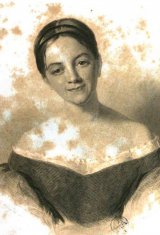Analysis of Scenes In London I - Piccadilly
Letitia Elizabeth Landon 1802 (Chelsea) – 1838 (Cape Coast)
The sun is on the crowded street,
It kindles those old towers;
Where England’s noblest memories meet,
Of old historic hours.
Vast, shadowy, dark, and indistinct,
Tradition’s giant fane,
Whereto a thousand years are linked,
In one electric chain.
So stands it when the morning light
First steals upon the skies;
And shadow’d by the fallen night,
The sleeping city lies.
It stands with darkness round it cast,
Touched by the first cold shine;
Vast, vague, and mighty as the past,
Of which it is the shrine.
’Tis lovely when the moonlight falls
Around the sculptured stone
Giving a softness to the walls,
Like love that mourns the gone.
Then comes the gentlest influence
The human heart can know,
The mourning over those gone hence
To the still dust below.
The smoke, the noise, the dust of day,
Have vanished from the scene;
The pale lamps gleam with spirit ray
O'er the park's sweeping green.
Sad shining on her lonely path,
The moon’s calm smile above,
Seems as it lulled life’s toil and wrath
With universal love.
Past that still hour, and its pale moon,
The city is alive;
It is the busy hour of noon,
When man must seek and strive.
The pressure of our actual life
Is on the waking brow;
Labour and care, endurance, strife,
These are around him now.
How wonderful the common street,
Its tumult and its throng,
The hurrying of the thousand feet
That bear life's cares along.
How strongly is the present felt,
With such a scene beside;
All sounds in one vast murmur melt
The thunder of the tide.
All hurry on—none pause to look
Upon another’s face:
The present is an open book
None read, yet all must trace.
The poor man hurries on his race,
His daily bread to find;
The rich man has yet wearier chase,
For pleasure’s hard to bind.
All hurry, though it is to pass
For which they live so fast—
What doth the present but amass,
The wealth that makes the past.
The past is round us—those old spires
That glimmer o’er our head;
Not from the present is their fires,
Their light is from the dead.
But for the past, the present’s powers
Were waste of toil and mind;
But for those long and glorious hours
Which leave themselves behind.
| Scheme | ABAB CDCD EFEF GHGH IXIX XJXJ KLKL MNMN OPOP QRQR ASAS TUTU VWVW WXWX YGYG XZBZ BXBX |
|---|---|
| Poetic Form | Quatrain (94%) |
| Metre | 01110101 111110 110101001 1101010 110010001 010101 1010111 010101 11110101 110101 0110101 010101 11110111 110111 11010101 111101 1101011 010101 10010101 111101 110100100 010111 01010111 101101 01010111 110101 01111101 1001101 11010101 011101 11111101 10101 111100111 010101 110101011 111101 0101101001 110101 1011001 110111 11000101 110011 010010101 111101 11010101 110101 11011101 010101 11011111 0111 01011101 111111 01110111 110111 0111111 110111 11011111 111111 11010101 011101 01111111 1101101 110101110 111101 110101010 011101 1111010010 110101 |
| Closest metre | Iambic tetrameter |
| Characters | 2,223 |
| Words | 386 |
| Sentences | 17 |
| Stanzas | 17 |
| Stanza Lengths | 4, 4, 4, 4, 4, 4, 4, 4, 4, 4, 4, 4, 4, 4, 4, 4, 4 |
| Lines Amount | 68 |
| Letters per line (avg) | 24 |
| Words per line (avg) | 6 |
| Letters per stanza (avg) | 98 |
| Words per stanza (avg) | 23 |
Font size:
Citation
Use the citation below to add this poem analysis to your bibliography:
Style:MLAChicagoAPA
"Scenes In London I - Piccadilly" Poetry.com. STANDS4 LLC, 2024. Web. 30 Apr. 2024. <https://www.poetry.com/poem-analysis/25699/scenes-in-london-i---piccadilly>.


Discuss this Letitia Elizabeth Landon poem analysis with the community:
Report Comment
We're doing our best to make sure our content is useful, accurate and safe.
If by any chance you spot an inappropriate comment while navigating through our website please use this form to let us know, and we'll take care of it shortly.
Attachment
You need to be logged in to favorite.
Log In